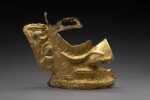 More than 500 important artifacts, including a rare gold foil mask, have been unearthed in six newly-discovered sacrificial pits at the Sanxingdui Bronze Age archaeological site in Guanghan, Sichuan, China. The gold mask is incomplete, but more than half of it survives. About 3,000 years old, the mask is large at nine inches wide and 11 inches high, the biggest of its kind ever discovered at the site. It weighs
More than 500 important artifacts, including a rare gold foil mask, have been unearthed in six newly-discovered sacrificial pits at the Sanxingdui Bronze Age archaeological site in Guanghan, Sichuan, China. The gold mask is incomplete, but more than half of it survives. About 3,000 years old, the mask is large at nine inches wide and 11 inches high, the biggest of its kind ever discovered at the site. It weighs  about 280 grams (10 oz) and is 84% pure. Archaeologists estimate that when intact, the mask weighed more than 500 grams, which would have made it not just the largest gold mask ever found, but also the heaviest gold object from the Bronze Age China.
about 280 grams (10 oz) and is 84% pure. Archaeologists estimate that when intact, the mask weighed more than 500 grams, which would have made it not just the largest gold mask ever found, but also the heaviest gold object from the Bronze Age China.
Crammed to the gills with bronze sculptures, vessels, bells, altars, tools as well as jade and ivory objects, when the first two sacrificial pits were 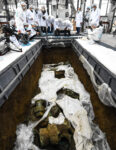 discovered within a month of each other in the summer of 1986, they revealed a previously unknown artistic style of such antiquity that upended the conventional wisdom that the dawn of Chinese art was centered in the Yellow River civilizations. Many of the objects found in the pits bore evidence of burning. Archaeologists believe the pits were used to house the ritual sacrifice of valuable and religiously symbolic objects. They were set alight in the pit and buried.
discovered within a month of each other in the summer of 1986, they revealed a previously unknown artistic style of such antiquity that upended the conventional wisdom that the dawn of Chinese art was centered in the Yellow River civilizations. Many of the objects found in the pits bore evidence of burning. Archaeologists believe the pits were used to house the ritual sacrifice of valuable and religiously symbolic objects. They were set alight in the pit and buried.
Artifacts from the Sanxingdui culture date to between 1700 and 1150 B.C. and attest to a highly developed bronze-making culture. The oldest free-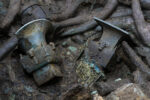 standing life-sized bronze sculpture of a human (8’6″) was discovered in one of the Sanxingdui sacrificial pits, as was a stylized bronze tree 13 feet high adorned with birds and flowers. The two pits also contained dozens of bronze masks, several of which were originally adorned with gold foil coverings like the one discovered in the recent excavation of Pit No. 5. Archaeologists hypothesize that the masks may have been mounted on wooden poles or perhaps worn in rituals to represent gods or ancestors.
standing life-sized bronze sculpture of a human (8’6″) was discovered in one of the Sanxingdui sacrificial pits, as was a stylized bronze tree 13 feet high adorned with birds and flowers. The two pits also contained dozens of bronze masks, several of which were originally adorned with gold foil coverings like the one discovered in the recent excavation of Pit No. 5. Archaeologists hypothesize that the masks may have been mounted on wooden poles or perhaps worn in rituals to represent gods or ancestors.
Sanxingdui is believed to have sat at the heart of the Shu state, which historians know relatively little about due to scant written records. Discoveries made at the site date back to the 12th and 11th centuries BC, and many of the items are now on display at an on-site museum.
The site has revolutionized experts’ understanding of how civilization developed in ancient China. In particular, evidence of a unique Shu culture suggests that the kingdom developed independently of neighboring societies in the Yellow River Valley, which was traditionally considered to be the cradle of Chinese civilization.
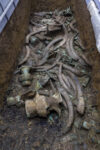 The Sanxingdui site has been archaeologically overlooked for decades, but a new push to study the rituals and ceremonies of this Bronze Age culture reopened excavations. These are the first new sacrificial pits found since the first two were unearthed 35 years ago. The third pit emerged on November 2019, and pits 4-8 were discovered from January through May 2020. They are rectangular in shape and range in dimensions from 38 square feet to more than 200 square feet. Archaeologists have excavated four of the pits to the artifact level and the remaining two to the fill layer covering the artifacts. Excavations will continue until the pits are fully explored.
The Sanxingdui site has been archaeologically overlooked for decades, but a new push to study the rituals and ceremonies of this Bronze Age culture reopened excavations. These are the first new sacrificial pits found since the first two were unearthed 35 years ago. The third pit emerged on November 2019, and pits 4-8 were discovered from January through May 2020. They are rectangular in shape and range in dimensions from 38 square feet to more than 200 square feet. Archaeologists have excavated four of the pits to the artifact level and the remaining two to the fill layer covering the artifacts. Excavations will continue until the pits are fully explored.
 Among the artifacts recovered are more gold ornaments — circles, birds, pieces of gold foil — bronze vessels with intricate anthropomorphic and zoomorphic decorative motifs, bronze masks, bronze trees, jade objects, whole trunks of elephant ivory plus carved ivory objects. Extremely rare bronze finds include a large vessel shaped like an owl and a complete zun, a wide-mouth drinking vessel
Among the artifacts recovered are more gold ornaments — circles, birds, pieces of gold foil — bronze vessels with intricate anthropomorphic and zoomorphic decorative motifs, bronze masks, bronze trees, jade objects, whole trunks of elephant ivory plus carved ivory objects. Extremely rare bronze finds include a large vessel shaped like an owl and a complete zun, a wide-mouth drinking vessel 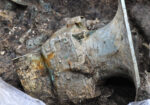 that was typically cylindrical; this one is square, making it unique among the many exquisite bronzes recovered from Sanxingdui. Its shoulders are adorned with the heads of birds and animals. Another was made in a dragon shape and is unique among known bronze ware types from this period.
that was typically cylindrical; this one is square, making it unique among the many exquisite bronzes recovered from Sanxingdui. Its shoulders are adorned with the heads of birds and animals. Another was made in a dragon shape and is unique among known bronze ware types from this period.
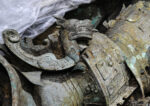 Organic remains were also found, including textiles, carbonized rice and seeds. There were fragments of two different kinds of silk: one a large quantity found in the ash layer of the sacrificial pit, so a direct offering that bundles of the highly-prized fabric were ritually burned in the sacrifice, the other found wrapping one of the objects of bronze ware.
Organic remains were also found, including textiles, carbonized rice and seeds. There were fragments of two different kinds of silk: one a large quantity found in the ash layer of the sacrificial pit, so a direct offering that bundles of the highly-prized fabric were ritually burned in the sacrifice, the other found wrapping one of the objects of bronze ware.